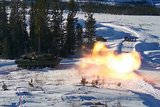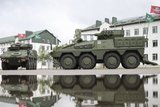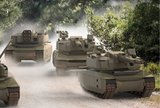US tests common hypersonic glide vehicle
The US Army and US Navy on 19 March successfully joint tested a hypersonic glide body during a trial carried out at the Pacific Missile Range in Kauai, Hawaii.
A Department of Defense (DoD) statement confirmed the launch of the Common Hypersonic Glide Body (C-HGB), which reached Mach 5.
Vice Admiral Johnny R Wolfe, director of the USN’s Strategic Systems Programme, said: ‘This test builds on the success we had with Flight Experiment 1 in October 2017 in which our C-HGB achieved sustained hypersonic glide at our target distances.’
‘Today we validated our design and are now ready to move to the next phase towards fielding a hypersonic strike capability’ he continued.
Once fully developed, the C-HGB will be made up of a conventional weapon warhead, a guidance system, cabling and thermal protection shield.
More from Land Warfare
-
Germany signs multi-billion-dollar deals for 6x6 CAVS and GDELS Eagle vehicles
The order is a further boost for the Common Armoured Vehicles System programme which has notched notable successes in the past 12 months. The first vehicle, made in Finland, will be delivered next year with local production expected to ramp up in 2027.
-
![Rheinmetall and KNDS tank tie-up narrows trans-European options]()
Rheinmetall and KNDS tank tie-up narrows trans-European options
The French and German governments signed an agreement in June 2018 to cooperate on the development of a new main battle tank under the Main Ground Combat System programme but the effort has struggled. This new agreement may damage it further.
-
![Hungary set to begin using Hero 400 loitering munitions]()
Hungary set to begin using Hero 400 loitering munitions
Developed by Israel's Uvision and with systems being sold in the thousands to multiple European NATO countries and the US, the Hero family of loitering systems is also in production in the US and Italy, the latter through Rheinmetall.
-
![Light Reconnaissance Strike – enabling a vital mission set (Studio)]()
Light Reconnaissance Strike – enabling a vital mission set (Studio)
A new system-of-systems concept will unlock digital integration of sensors and weapons for Light Forces, allowing them to shape the battlefield environment on their own terms and upgrade legacy platforms.

























